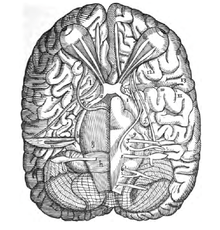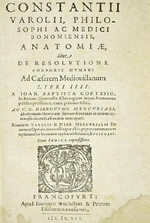Costanzo Varolio
Costanzo Varolio, Latinized as Constantius Varolius (1543–1575), was an Italian anatomist and a papal physician to Gregory XIII.[1]
Costanzo Varolio | |
|---|---|
 Illustration from De Nervis Opticis by Varolius | |
| Born | Constantius Varolius 1543 Bologna |
| Died | 1575 (aged 31 - 32) |
| Nationality | Italian |
| Occupation | Anatomist and papal physician |
| Known for | Work on the cranial nerves |
| Medical career | |
| Institutions | Sapienza University of Rome |
| Research | Erectile function |
Varolio was born in Bologna. He was a pupil of the anatomist Giulio Cesare Aranzio, himself a pupil of Vesalius. He received his doctorate in medicine in 1567. In 1569 the Senate of the University of Bologna created an extraordinary chair in surgery for him with responsibility to teach anatomy as well and where a statue of him is housed at the Anatomical Theatre of the Archiginnasio. Later he is believed to have taught at the Sapienza University of Rome although he is not listed on the roll there. Nevertheless, he is known to have had considerable success in Rome both as a physician and as a surgeon and his memorial plaque in that city refers to his great skill in removing stones. He died in Rome.
He is best remembered for his work on the cranial nerves. He was the first to examine the brain from its base upwards, in contrast with previous dissections which had been performed from the top downwards. In 1573 he published this new method of dissecting the brain whereby he separated the brain from the skull and began the dissection from the base. Varolio described many of the brain's structures for the first time including the pons or pons Varolii which is a reflex center of respiration and a communication bridge between spinal cord and brain, the crura cerebri and the ileocecal valve.[2]

Another area of interest to him was the mechanism of erectile function. Although the “Musculi erectores penis” (i.e. Mm. bulbospongiosi and ischicavernosi) had already been described by Galen in the 2nd century A.D., this knowledge was lost by the time of Varolio, who re-discovered them and gave a surprisingly accurate description of the mechanism of erection although his inaccurate attribution of erection to "erector muscles" continued to be believed by most anatomists for three centuries.[3][4]
Varolius' work is the following:
De Nervis Opticis nonnullisque aliis praeter communem opinionem in Humano capite observatis. Ad Hieronymum Mercurialem, Patavii apud Paul et Anton. Meiettos fratres, 1573, 8º, 8 and 32 leaves. It consists of a letter to Girolamo Mercuriale, dated April 1, 1572, his answer, and Varolius' reply to the latter. Appended are three woodcuts pertaining to the brain and drawn by Varolius himself. The engraving is somewhat crude, yet distinct and instructive.[5]
A second work by Varolius, a teleologic physiology of man, was published for the first time after his death: Anatomiae sive de resolutione corporis humani ad Caesarem Mediovillanum libri iv, Eiusdem Varolii et Hieron. Mercrialis De nervis Opticis, etc. epistolae, Francofurti, apud Joh. Wechelum et Petr. Fischerum consortes, 1591, 8º, 8 and 184 pp. This contains one illustration. The former book is republished as a part of this work with unchanged text and the woodcuts recarved in a somewhat different manner.[5]
References and notes
- Mandosio (disputed by Marini)
- MARTINOTTI G. (1926), Costanzo Varolio e il suo metodo di sezionare l'encefalo. Galeati
- ED LOGS (2006) Historical Highlights of Erectile and Sexual Dysfunction An Illustrated Chronology.
- Richard Herring (2004), Talking Cock: A Celebration of Man and His Manhood, Thunder's Mouth Press ISBN 1-56025-608-7
- Ludwig Chulant, (1852), History and Bibliography of Anatomic Illustration. (Translated from the German by Mortimer Frank), University of Chicago Press
External links
- Il Catalogo Unico delle Biblioteche Italiane
- Bio Infobank Library
- Tubbs RS, Loukas M, Shoja MM, et al. (March 2008). "Costanzo Varolio (Constantius Varolius 1543-1575) and the Pons Varolli". Neurosurgery. 62 (3): 734–7, discussion 734–7. doi:10.1227/01.neu.0000317323.63859.2a. PMID 18425020.
- Gaetano Luigi Marini, Degli archiatri pontifici, 2 vols. (Roma, 1784)
- Milestones in Neuroscience Research, Eric H. Chudler.
- Varolio at the Galileo Project
- Richard S. Westfall, Department of History and Philosophy of Science, Indiana University.